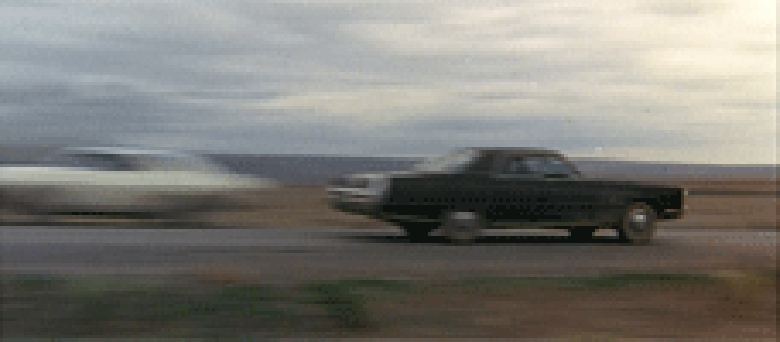Reviews
Richard C. Sarafian
USA, 1971
Credits
Review by Rumsey Taylor
Posted on 29 January 2008
Source Fox DVD
Related articles
Reviews Two-Lane Blacktop
Vanishing Point contains expository dialogue, much of it in the form of a radio broadcast deejayed by a man named Super Soul. With the aid of a police scanner he provides evasion guidance intended for the film’s central character, Kowalski, a driver behind the wheel of a Dodge Challenger committed to drive west across three states as fast as possible. But as advancing as this dialogue may be, the exposition rests equally on Kowalski’s exhausted face—perched firmly forward-facing, his eyes squinted open, bloodshot, and never blinking. He’ll turn only for quick glances toward the rear-view mirrors, and then again forward, incredulous to the increasing potential for capture.
This is essentially all we need to know about Kowalski, that he must go forward and he must not stop— Vanishing Point is above all else a film about impetuousness. He is motivated superficially by a bet—that he can deliver the Charger to San Francisco within fifteen hours from departure (just after midnight in Colorado). This deadline is soon missed because Kowalski’s antics attract the authorities, who follow his route with increasing attention, and ultimately force him off-road. Arrest, we know, would be an anticlimax, so Kowalski speeds on and on. Basically the entire film is this, Kowalski in or near his supercharged Charger, headed west.
Between its opening and its explosive conclusion is an array of landscapes and a bare modicum of characters, each of them a stereotype. By design these characters - including a gay couple and an old drifter who collects and pawns rattlesnakes - enliven the periphery, which is incidental in a film that spends much of its time zooming forward. These characters remain minor, but they serve to enhance the character of Kowalski, whose only other trait outside exhaustive determination is his solemn humanity. He outmaneuvers a pair of policemen on motorcycles - one sliding to a stop in a forest embankment, the second tumbling down a dirt cliff - and Kowalski stops unexpectedly to verify the health of his pursuers, and then on he goes. This humanity is further established in a series of flashbacks at regular intervals, illustrating Kowalski’s past as a professional racer, his former love, and even his work as a law officer. His journey is not facilitated by greed or criminal prestige, but something more ambiguous and fleeting; he knows, possibly better than the viewer, that he cannot reach his destination, for the journey enables his end.
Belonging to a myriad of early-Seventies counterculture road trip films (Easy Rider and Two-Lane Blacktop the only two others I’ve seen), Vanishing Point shares its cues with these films. (Save for Mountain’s “Mississippi Queen,” much of the film is driven by an incessant hi-hat cymbal persuasive to 70s action movies.) The make of the automobiles notwithstanding - which even car freaks as dispassionate as I will realize is the most integral cultural feature of these films - the film connotes preferences for freedom and resistance to racism, with Kowalski exemplifying both aspects. He’s aided by a pair of hippies toward the end, for example; one just rides up beside him at about 70 m.p.h. and asks if he needs help. In one of only a few of instances in which he speaks, Kowalski accepts the offer. The aforementioned deejay is black, and his broadcasted support becomes resisted by the authorities—all of them rather hostile whites, who enter the radio studio with unwarranted abandon to prohibit Super Soul’s aid. Kowalski, with his distinctly un-American name and his resistance to conformity, is the more predominant threat to them. As he passes the border of Colorado and then Nevada, the policemen admit he hasn’t committed any felonies, thus they cannot pursue him past the border. Yet their hostility is manifest, and effective in mobilizing the law in neighboring states. Kowalski, their actions imply, isn’t as much a threat to road safety as he is to an American ideal that vests little interest in the individual.
In Vanishing Point Kowalski is a hero as long as he remains free, and the longer and faster he drives the more improbable his escape. By this measure self-destruction becomes his defining characteristic, which makes it difficult for me to identify with Kowalski directly, considering the freedom he seems only passingly intent to secure is ambiguous. (For one, the car he’s delivering will be in less than optimum condition.) In addition to his evasion of the law, Kowalski is depriving the viewer of his true motivations. It’s easy - and perhaps more appropriate - to see him as more of an archetype of resistance, which is something that also describes the drivers in Two-Lane Blacktop—you’re to understand, basically, that freedom is derived from sustaining one’s personal ideals, even if said ideas are apathetic.
The film opens with what is apparently the story’s conclusion, Kowalski, having evaded the law in three states, speeding toward a roadblock in Cisco, California. He eyes it about a quarter mile down, and suddenly spins the Challenger around and off the road, escaping, again, successfully. Initially, this seems likely enough, and does well to elicit sympathy for Kowalski even though nothing is really known about him. Later, the film arrives at this same scenario, only this time with Kowalski speeding toward it - a pair of bulldozers facing him, their blades positioned beside each other, and a glimmer of light, of freedom, between them - with gathering momentum.
We don’t do comments anymore, but you may contact us here or find us on Twitter or Facebook.



